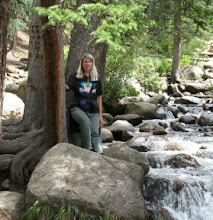Two events conspired to renew my level of botanical engagement this month. The second was Mary, the
Accidental Botanist, who posted a piece about
ThePlantList.org, a great resource for people (Mary aptly calls "plant nerds") who want to figure out more about a plant.

But the original reason I needed to re-engage was work-related: a project that gave me an excuse to learn more about the rare plants at
Summit Lake Park, the alpine contribution to Denver's Mountain Park System. I need to know what these plants look like, and I won't be making any trips to Mt. Evans or Summit Lake in January (see photo). Could the new
PlantList site help me?

In two clicks, on my first attempt*, I found myself looking at an image of
herbarium specimen #K000697587 of
Draba exunguiculata at, incredibly, the Kew Herbarium! It was collected near Gray's Peak in 1885!
*Okay, not quite that easy. Plantlist has a typo; I had to add an "n" to the species epithet to make it work.
Quite a few of the rare plants at Summit Lake are mosses and liverworts (bryophytes). In another two clicks, this time over to the New York Botanical Garden, I was studying a map of locations of specimens of the rare moss,
Oreas martiana. Although 16 of the 39 specimens at NYBG are from Colorado, the map showed only six locations on the North Slope of Alaska, one in northern British Columbia, and two in Greenland. Ahh, there's the wrinkle: The specimens have to be "georeferenced," that is with coordinates recorded, in order to be plotted, and many, it seems, are not.
The Plant List, sad to say, deals only with vascular plants and bryophytes. You'd think 298,900 valid names (and more than a million total) would be enough to satisfy anyone, no?
As I said in a
previous post about Summit Lake:
 I’m a bit daft about cryptogams, and it seemed everywhere we tried to put a flag, the “bare” ground was thick with lichens and mosses. Tundra lichens are a special breed—most are species that dominate arctic ecosystems and aren’t seen down here in the lower 48 states, except at very high altitudes. So they’re special, at least to me.
I’m a bit daft about cryptogams, and it seemed everywhere we tried to put a flag, the “bare” ground was thick with lichens and mosses. Tundra lichens are a special breed—most are species that dominate arctic ecosystems and aren’t seen down here in the lower 48 states, except at very high altitudes. So they’re special, at least to me.
What about my favorite arctic tundra lichens that also occur at Summit Lake? No help from the PlantList there, but I was hooked on the concept. Lichen images are rarely a problem; Steve and Sylvia Sharnoff have helped us out with their definitive book and website at
Lichen.com. (And Steve's more
extensive photo gallery, a wonderful place to explore on a snowy winter's day.)
A quick visit over to the American Bryological and Lichenological Society (ABLS)
website reminded me I should drop in on the lichen herbarium at Arizona State University, where Dr. Thomas Nash has amassed more than 109,000 lichen specimens. Searchable... Now
that sounds promising!
Instead of searching only the ASU collection, though, I found myself presented with
this opportunity to search lichen herbaria across the US and Canada! Enter a taxon, and/or maybe some criteria, and pow! you've got label data from any of the 15 institutions in the
Consortium of North American Lichen Herbaria.

A few more clicks, and you'll have a map of all the georeferenced specimens in the database, or maybe a list of all the lichen specimens collected within a given distance of whatever coordinates you care to enter. If you ask for all the occurrences of the arctic lichens
Dactylina madreporiformis (aka
Allocetraria madreporiformis) and
Thamnolia vermicularis, you get 515 specimens in ten (counting subspecies) taxa, that look, on the map, like this. The
Dactylina is red;
Thamnolia blue.

The armchair explorer can click each little map bubble to view a specimen label for that site. If multiple specimens occur there, a list of them pops up, and you can pick which label you want to see.

If you have a microscope handy, you can even try using a Dynamic Key to the lichens of an area, as in
this one for the 348 lichen species within 40 miles of Summit Lake. The key will walk you through the characters, eliminating species at every choice (pick a feature you know, if possible, or can make an educated guess at), until you arrive at your answer. Unfortunately, the first big steps in elimination require you to know quite a bit about the lichen's innards, like spore features and what the photobiont (algal partner) is. If you happen to know it's cyanobacterioid, you're in luck; you'll only have to work through 36 species. Alas, about 90% of lichens involve green algae, often
Trebouxia, as the primary photobiont.
Easy way to lose a week or two (as I did)... If Dr. Weber's lichen collection* at the CU Boulder Herbarium (COLO) was in the database, I'd be in real trouble!
You say you're not particularly fond of lichens? We'll have to address that in a future post...——
* Specimen data aren't online, but you can explore his
Catalog of Colorado Lichens.
For
Berry-Go-Round #36... "Botanical" is in quotes because lichens aren't really considered to be plants by most people. These days they're organized as "lichenized fungi." But BGR says it's okay "as long as a reminder clearly indicates fungi and algae are not considered plants anymore." This is my reminder.
 The latest edition of the Berry-Go-Round plant carnival is now posted at Seeds Aside.
The latest edition of the Berry-Go-Round plant carnival is now posted at Seeds Aside. 









